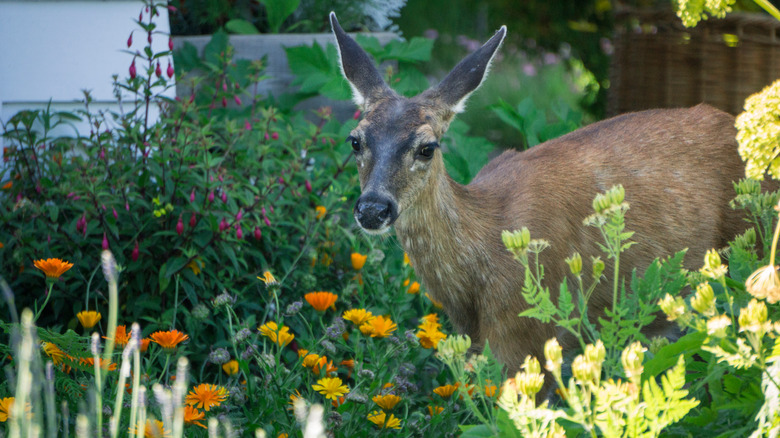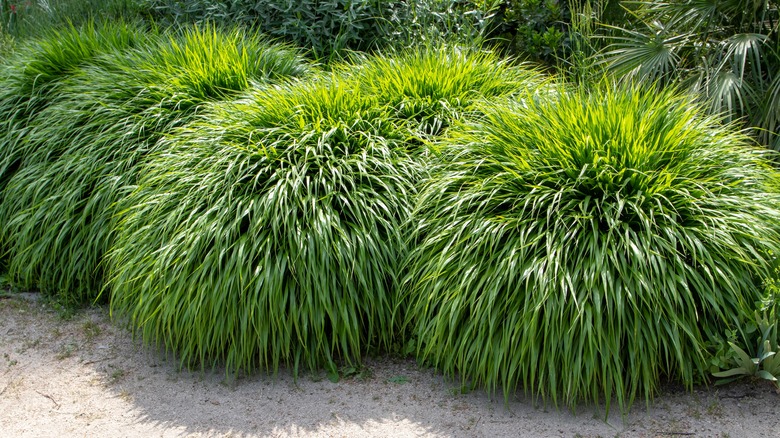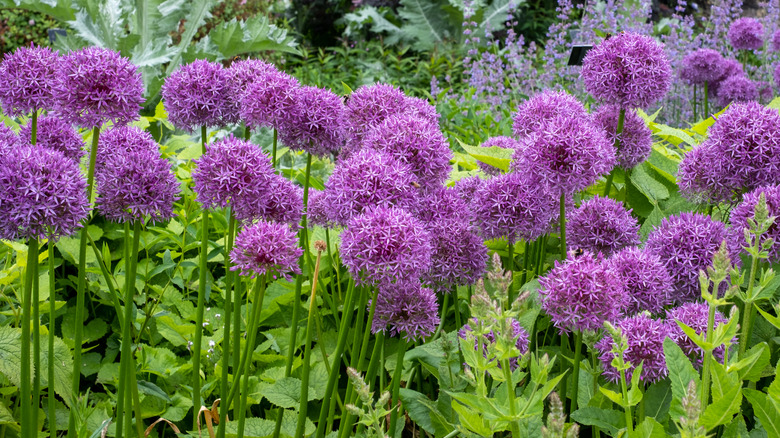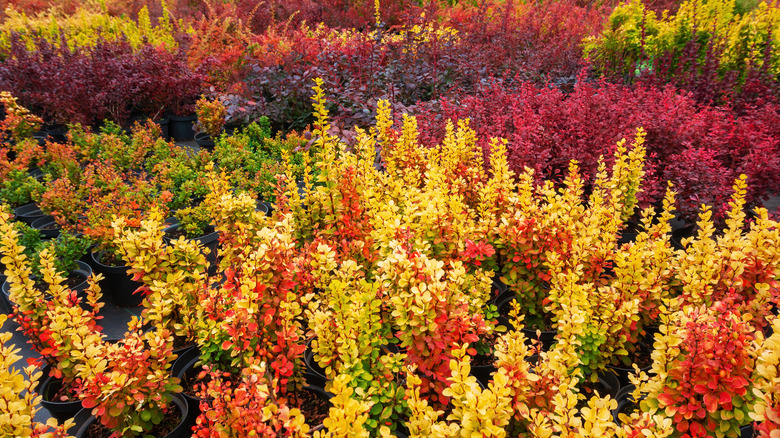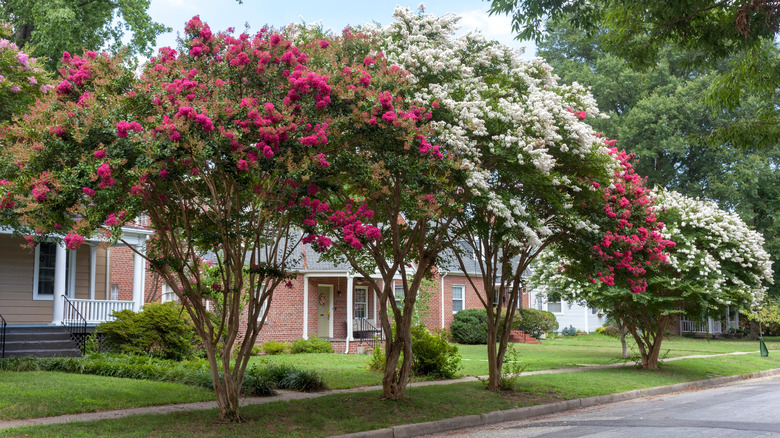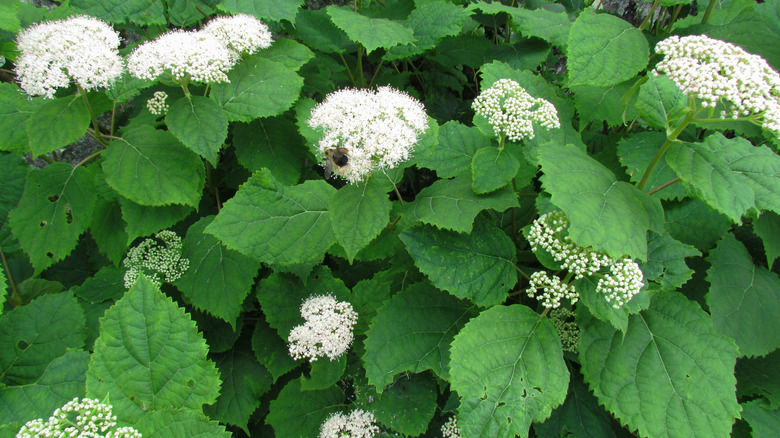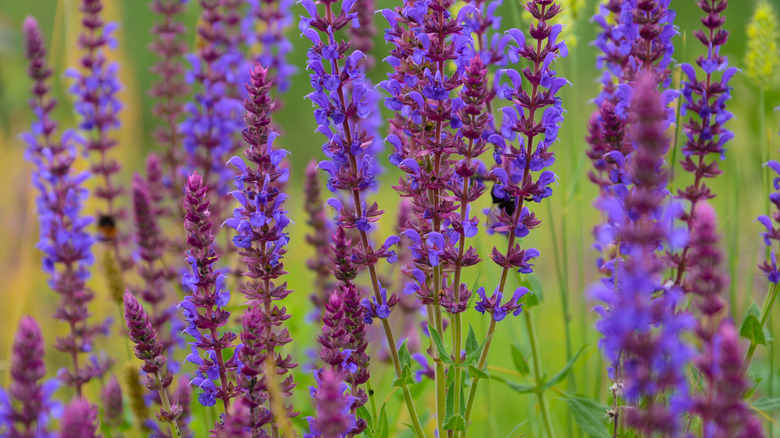Deer-Resistant Plants That Will Bring Color To Your Yard, According To A Gardening Expert
Despite encroaching human developments, researchers estimate that deer populations in North America have more than doubled in the last decade, reaching approximately 30 million today (via The National Gardening Association). There are over 38 species of deer around the world, but whitetail deer and mule deer present the biggest nuisance to American gardeners. Some gardeners have taken some desperate and costly measures to keep deer away from their plants, trying everything from 8-foot fences to chemical repellents and motion-activated deterrents. It can be very frustrating to put time, money, and energy into a garden only to have your best blooms devoured by morning.
In an exclusive interview with House Digest, Tim Flood, head horticulturist at Nature Hills Nursery, revealed some of the best plants to bring color to your yard without attracting deer. Of course, Flood tells gardeners to "keep in mind that if deer populations are high and food becomes scarce, deer may sample almost any plant just to survive." Every deer population is unique, so Flood recommends talking to neighbors to determine which plants seem to fare best in your area. With that being said, you don't have to sacrifice your garden's beauty for survivability. Flood says, "there are some plants that in many areas the deer do not prefer, and [that] seem to be able to be grown without issue."
Ornamental grasses
Deer can be seen chowing down on clovers, forbs, weeds, and rushes, so grass may seem like the last thing you'd want to plant in a deer-resistant garden. However, not all grasses appeal to deer. Ornamental grasses are often spared because they typically have a tough, dense, and shiny texture that makes them hard for deer to pluck, chew, and digest. According to Plant Addicts, the tough texture of ornamental grass can also repel rabbits, gophers, and other garden nuisance animals. In addition to being very deer-resistant, ornamental grasses can add a lush, modern appearance to your garden or yard.
Tim Flood recommends planting ornamental grasses throughout your garden because they are adaptable to many soil and sunlight conditions. Although many ornamental grasses don't produce flowers, Flood says, "many have colorful foliage, and the seed heads can also be very showy — and remain wildly attractive all winter long." Although they are often treated as filler plants, ornamental grasses are far from boring. "Color, movement, and easy-to-grow perennial grasses vary greatly in size," Flood says, "so be sure to pick a grass that works for your landscape." For the best decorative effects and deer-resistant properties, Flood recommends several grass varieties, including Flame Grass, Fountain Grass, Switch Grass, Little Bluestem, or Japanese Forest grass.
Flowering allium
There are some plants that deer will typically avoid due to their pungent smell or taste. Members of the allium family, including onions and chives, don't usually appeal to hungry deer. Eating onions can even result in health consequences for deer, including anemia, according to American Tarantula & Animals. A yard full of onions may not sound like a landscaper's dream, but plants in the onion family can vary greatly, and some varieties, like the flowering allium, can make a bold, colorful statement in your garden. Far from your standard grocery onion, Tim Flood inspires gardeners to picture tall, purple, yellow, or white blooms popping up from the foliage.
Flood elaborates, "Flowering Allium (onion) have become outstanding perennials because of the fact that deer really do not like the flowers or the foliage. [Alliums] simply love a sunny site combined with well-drained soils and that combo will produce an excellent crop for you." If you're hoping to unite the gardening community near you, alliums are an excellent gardener's gift. "They all make great cut flowers," Flood says, "and they are all easy to grow and multiply nicely to divide and share with your neighbors too." The deer won't enjoy eating this lovely flowering plant, but you certainly can! According to The Right Flowers, allium blossoms have been used for centuries in cooking, medicine, and decoration, so you can enjoy both aesthetic and edible benefits from these deer-resistant plants.
Barberry shrubs
Similarly to ornamental grass, deer will typically pass over dense shrubs. Stems, thorns, and waxy leaves are understandably difficult to chew and digest, so deer would much prefer to graze on smaller, softer plants. Because of their hardy nature and shapeability, shrubs can work well for a variety of garden designs. Tim Flood says, "Sun-loving and drought-tolerant shrubs make great sheared plants, or grow more naturally [if they are] less pruned." Barberry shrubs are a particularly unique and low-maintenance way to boost the color factor in your garden.
For gardeners who want a bushy and dense display of colors throughout all four seasons, it's hard to beat the fiery shades of the barberry shrub. Flood explains, "Barberry shrubs may not be known for the impressive flower display, but holy cow — check out the many different selections that [Nature Hills Nursery has] with bright yellow, chartreuse, orange, purple, red, gold, bi-colored and greens."
Deer clearly don't like Barberry thorns, but Flood hints that these plants may deter other unwanted guests too. He states, "Barberry plants make outstanding barrier plants for hedges to keep people and deer out. Nobody wants to walk through a hedge of barberry plants."
Crape myrtles
A classic among gardeners and landscapers, crape myrtles are hardy, easy-to-grow, and eye-catching plants that are generally deer-resistant. Crape myrtles thrive in a wide range of environmental conditions and can be pruned and guided to the gardener's liking. According to Tim Flood, crape myrtles "can be grown as perennials or shrubs, or sometimes you will see them as a clump or single-stem trees." As with many plants on this list, deer-resistant does not necessarily mean deer-proof. Crape myrtles are typically unbothered by deer, but they may take a few nibbles if they are desperate enough for food. Nonetheless, crape myrtles are still a worthy addition when cultivating a colorful, deer-resistant garden.
Flood encourages gardeners to "Imagine a plant that can flower from summer into fall with these massive panicles of bloom in the most impressive colors." It's true that crape myrtle species come in an astonishing variety of colorways, from bright red Dynamite to lavender Majestic Orchid and mixed tones like Peppermint Lace. Whatever blossom color and plant size you choose, Flood insists that the massive, full blooms "will really bump up the volume of your landscape." In exchange for such impactful color, crape myrtles require minimal care. Flood recommends planting your crape myrtle in a sunny location with well-draining soil and pruning annually only if needed.
Arrowwood viburnum
Tim Flood describes arrowwood Viburnum as "A multi-season interest plant that is sure to please and easy to grow." Flood says he recommends this plant because "Arrowwood Viburnum and the cultivars that have been selected over the years show excellent resistance to deer feeding on them." Viburnum species usually have fuzzy, hairy leaves and stems that irritate deers' throats and tongues. In addition to their unpalatable texture, many Viburnums also produce a sour scent that is unappealing to deer. Even if your local deer are brave enough to take a bite, repellent retailer Nature's Mace says not to worry; most viburnum species bounce back quickly after being pruned or chewed.
Flowers of the arrowwood Viburnum are a lovely, lacy white, but Flood suggests that the plant itself also lends some valuable color. As he describes it, the plant's "super glossy green leaves in summer turn an excellent mix of purple and red and yellow in the center of the shrub. The white flower clusters give way to blue-black fruits born in those clusters." In addition to providing a bold contrasting color, the dark bluish arrowwood berries are great for attracting other wildlife to your garden. Some potential guests include songbirds, chipmunks, squirrels, and even wild Turkeys. To encourage pollination fruit production, Flood recommends planting at least two kinds of arrowwood Viburnum.
Salvia
It can be hard to find bold, colorful plants that attract attention without attracting deer. Most hardy, deer-resistant plants fall short in the color department, but salvia is one incredible exception. "Drought tolerant and reblooming beautifully, this perennial plant is a winner in today's landscapes," says Tim Flood. Salvia plants typically grow between 12 and 24 inches tall, but some can reach impressive heights up to 5 feet (via Clemson University). Deer will almost never touch salvia due to its strong scent, but the earthy aroma seems fresh and pleasant to humans. The bright purple, red, pink, or white blooms are highly appealing to pollinators, including bumblebees, butterflies, and hummingbirds.
Wondering where to place salvia in your yard for the best results? Flood says, "compact and easy-to-grow perennials are great in mass or sprinkled throughout your perennial border." This means that salvia will thrive when planted along the borders of your property, such as along the fence or near hedges and walls. Salvia's gorgeous, colorful blooms are sure to delight people as they pass by, and Flood says they can also make lovely cut flowers for a bouquet. Salvia blooms along the fence may even send a message to your local deer, declaring, "there's no food for you in here!"
